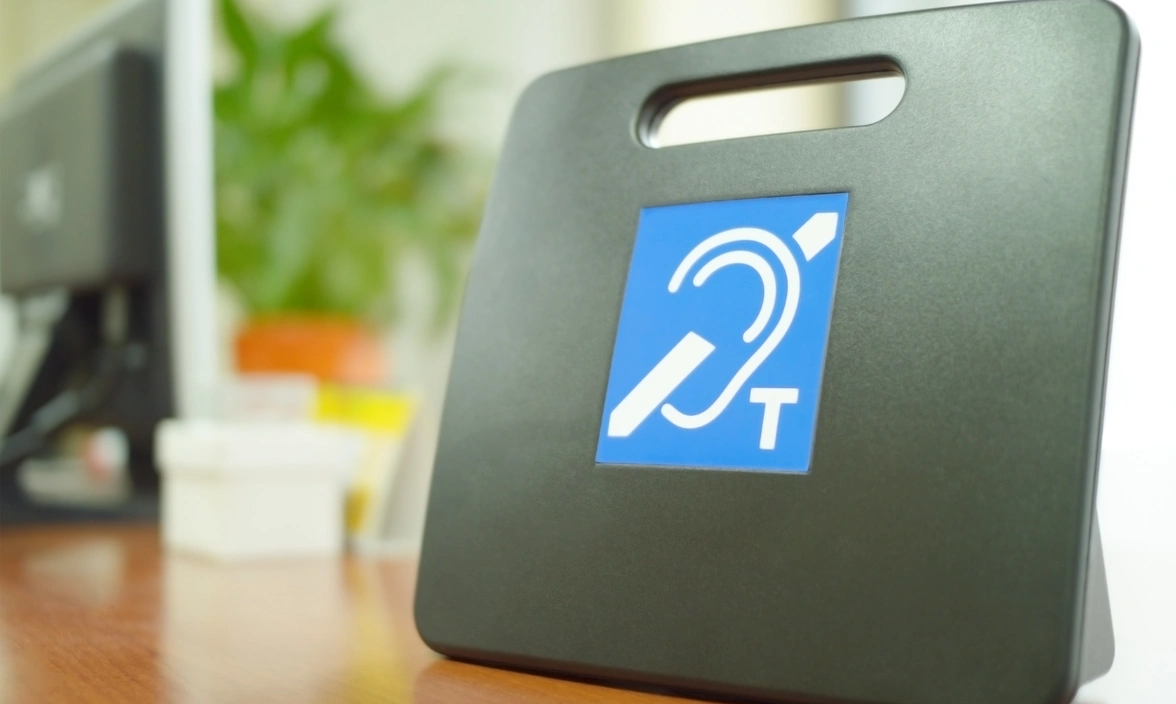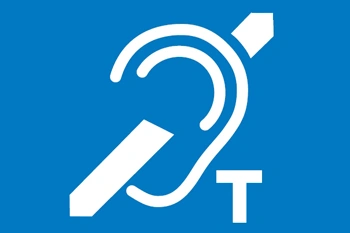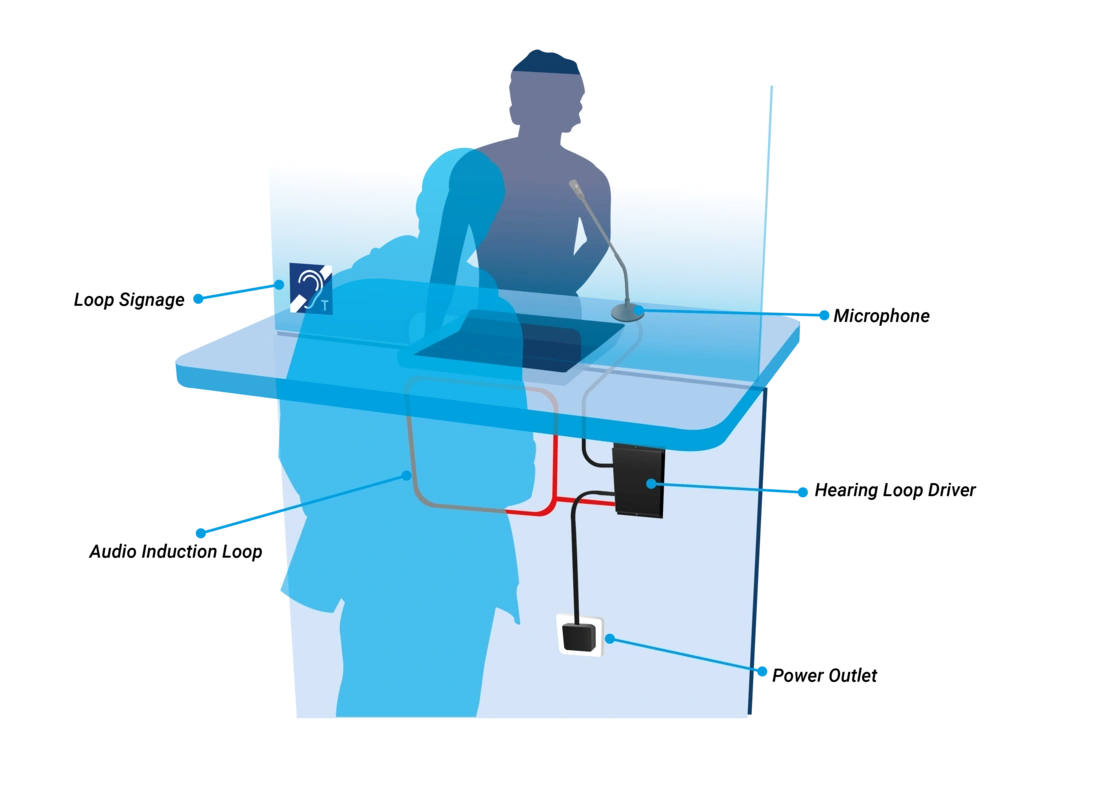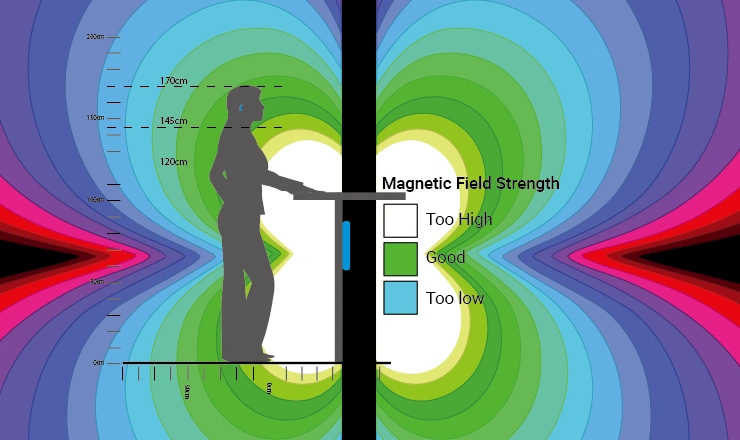Hearing loops
Below you will find an introduction to hearing loops, what they are, how they work and who to contact for more information or installation.
Below you will find an introduction to hearing loops, what they are, how they work and who to contact for more information or installation.

A hearing loop is a special type of sound system for use by people with hearing aids. It can also be known as an audio induction loop or induction loop.
A hearing loop provides a magnetic, wireless signal that is received by the hearing aid when it is set to ‘T’ (Telecoil) or Loop setting.
It is the only assistive listening technology that can broadcast directly to a wide range of hearing aids, making them the most popular option for accessible audio in public spaces.
The hearing loop consists of an audio source, connected to an amplifier, which processes the signal and transmits it through to the final piece, the loop cable. In its simplest form, this is a wire placed around the perimeter of a specific area e.g. a church or a small meeting room, but can be a specially designed layout to cover more complex areas.
The audio input for a hearing loop is often a microphone to pick up the spoken word but can be any sound source, e.g. from a TV set in your living room, to announcements in an airport or the sound system in a theatre.

You can find hearing loops in a wide variety of locations. In public spaces they are found on service counters in shops, banks, or reception desks. You may come across them on public transport, meeting rooms, help points or intercoms. If you go out and about with friends, you may encounter them in theatres, cinemas or museum tours.
Wherever you may go, you will know there is a hearing loop provided by a sign which features the internationally recognised hearing loop symbol. This indicates a hearing loop can be used.
They are designed to provide easy access to high-quality audio, helping to ensure that people with hearing loss have inclusive and equal access to intelligible sound.
Find out why it is good practice to provide a hearing loop for your customers, and other information about making hearing loop technology available.


Courtesy of Contacta
This video requires marketing cookies to be viewed. Please accept cookies to view this video content.
Courtesy of Ampetronic
This video requires marketing cookies to be viewed. Please accept cookies to view this video content.
Thank you to Contacta and Ampetronic for their help in creating this page. Contact them for further information or to discuss hearing loop installation.
If your hearing aid has an obvious ‘T’ setting on the programme switch, then this is typically for selection of the loop function. With many hearing aids, there is no way of knowing by looking as to what programme options your hearing aid has. It is important to check with your audiologist. Sometimes hearing aids may have a telecoil fitted but not enabled. Your audiologist can ensure this is programmed for you. They will also be able to advice if a telecoil compatible accessory is available to use in conjunction with your hearing aid. This may not be included in the provision of the aid and may cost extra.
Most likely the answer will be yes. This is dependent upon the model of processor you use. When you are prescribed an implant, be sure to the implant team about what settings or programmes can be used. They will also be able tell you about the specific features for your implant.
Yes, by using a loop listening device. Some venues may provide these for users without a compatible hearing aid.
If you are purchasing a hearing loop system, suppliers will typically advise you of the right model for the size of the room you will be using it in. There are a variety of types and price, so your personal requirements will influence the type and cost incurred. Make sure you tell the supplier what audio sources you wish to use with your loop so the correct inputs and connections can be allowed for.
In some areas of the UK, hearing loops may be provided free or subsidised by Social Services or Sensory Impairment Teams; you may need to be assessed before this is provided to you via this route. If you are unsure what the local provision is in your area, then speak to your audiologist – they often know the system and may even refer you.
You will find hearing loops in lots of different venues and public spaces, including: churches, theatres, council offices, hospitals, shops, banks, and public transport.
Whichever venue or service you are using, there should be a hearing loop sign indicating that a loop is available.
If you cannot hear anything from the hearing loop provided you should inform a member of staff who will then get the loop checked out. If the service provider does not provide the appropriate equipment or they do not keep it maintained properly they could be in breach of the Equality Act and be open to legal action.
Registered charity in England and Wales no. 293358 and in Scotland no. SC040486. Royal Patron HRH The Princess Royal.